The trouble is you can't do more than one excursion in any one day, and you either have to rent a car (no!), rely on the infrequent bus service (not optimal for gray or wet days), or bite the bullet and sign up to go with a group.
Today is your typical Icelandic summer day: cool, cloudy and occasionally wet. My plan to take a public bus out close to a hike in the direction of a hot river suddenly seems unattractive. And so early in the morning, I walk the deserted streets of the city, thinking that it feels not unlike any European city on a Sunday morning: the locals are sleeping in, the tourists, not wanting to waste a minute, are wandering around in search of a good cup of coffee.
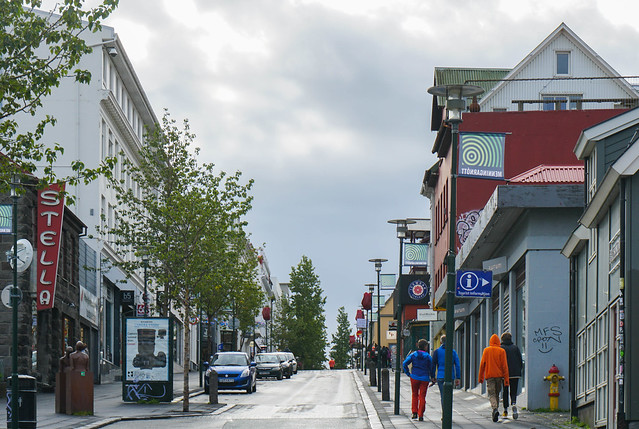
I go to the Tourist Office to discuss my options. I'm hoping to get one of those confident agents who knows exactly what I should do and how I should go about doing it.
That doesn't happen. Even at 8:30, she tells me I'm too late for the day long tours that took off at 8. She pushes whales and geysers. I remember waiting forever to see Old Faithful (the geyser) at Yellowstone when I was a kid. I took a photo. Water went up, water came down. I took another photo. It looked much the same as the first. As for whales -- you already know how far I will travel to avoid being on a boat right now. I would go to see the puffins, because I do love puffins, but I'm spoiled by my incredible up close and personal trip to the islands off the coast of northern England. Watching puffins distantly, from the hull of a rocking boat, is going to be far less fun.
And then the agent says the perfect thing: how about riding an Icelandic horse? Well now!
The Icelandic horse is a unique breed of horse: short, stout, hardy, energetic. Most horses have only three natural gaits (walk, trot, gallop). Some breeds have four (add canter). The Icelandic horse is known for having five (walk, trot, tölt, canter, and the flying pace; the tölt is so smooth that it is said you can drink a pint during it and not lose a drop, and the flying pace has all four hooves suspended in the air at once -- very remarkable and very fast!).
You could also say of this animal that it is the most purebred horse on earth. It lives in Iceland and has remained exclusive to this island since the Vikings introduced livestock here more than 1200 years ago. It does not succumb to disease, because the law forbids other horses from being brought in (and if an Icelandic horse leaves the island, it cannot come back). Riding equipment has to be brought in new, or be subject to thorough disinfection.
Icelandics (as the horses are called) are social, intelligent and since there are no predators on the island, they rarely spook. But for me, they are simply lovely to look at. And perhaps enjoyable to ride.
But first, breakfast. I'm back at Sandholt Bakery. There are other breakfast places in town, but the pastries here stand out. Again I eat a hearty breakfast-lunch combo -- skyr with blueberry compote, juice, a smoked salmon sandwich and a yeasty poppy seed roll. (Skyr is Icelandic yogurt. Some actually say it's a cultured milk product that is closer to cheese. It's like Greek yogurt, only milder in flavor and always made with skim milk. You'll often see it on my breakfast table -- in the US it often appears under the "Siggi's" label.)
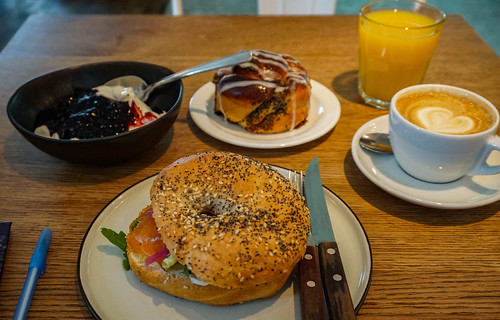
Though Sandholt is again crowded, this time I hear many more American voices. In fact, on both sides of me, I pick up the unmistakable New York accent. To my left, two women are listlessly reviewing every morsel of consumed food, to my right, a couple is acting as if perhaps this trip together was not such a good idea, though he is still trying to stay upbeat. She -- less so. I'm thinking that sometimes it's better not to understand the words of your neighbors. This morning I almost feel their gloom.
Okay, the couple leaves and a young family sits down. Icelandic people for sure. So good to once again not understand a word of what my neighbors are saying.
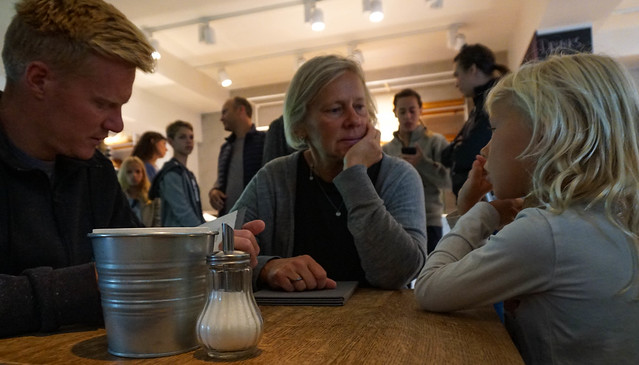
I have a little time left and I decide to use it for a trip up the tallest structure in Iceland -- the Hallgrimskirkja, a Lutheran church that some say resembles the distinctive basalt stone formations found around Iceland and others (me!) think it looks more like a spaceship.
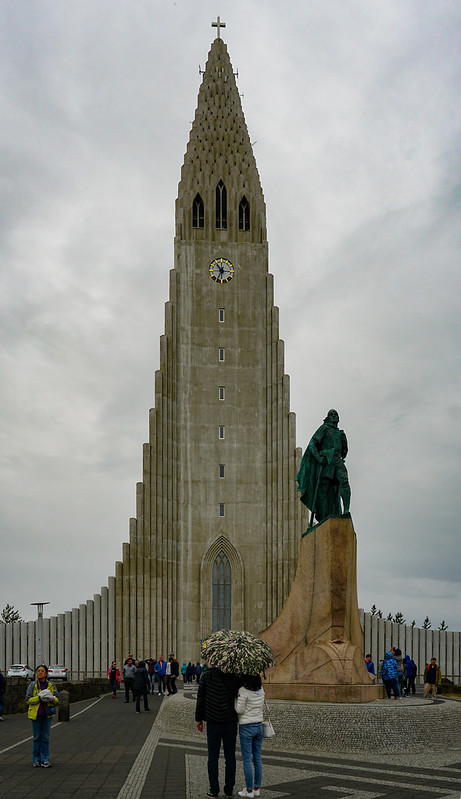
(the views are okay...)
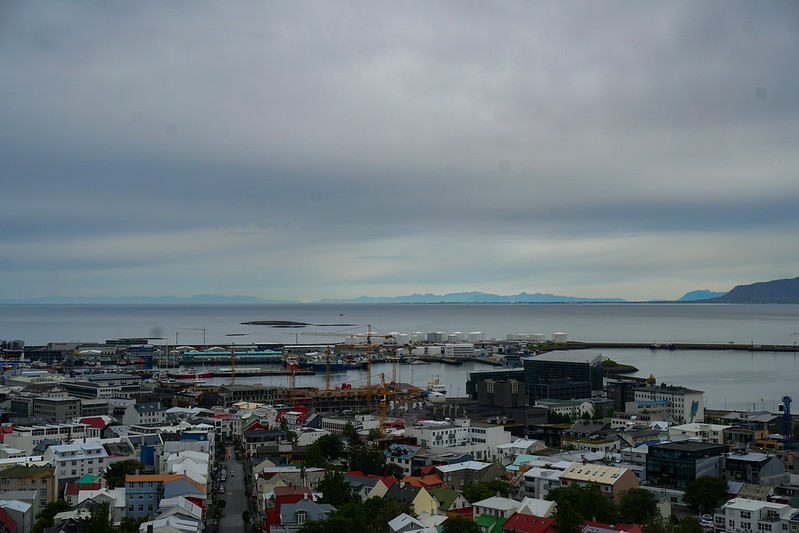
In front of the church there is an imposing statue of Leifur Eiriksson, with a sign boasting of his "discovery" of North America (you see it of course in the church photo above). It's a gift from our country (and if you want to see Leifur without having to cross the ocean, you can go to Newport Virginia, where an identical copy stands) and Icelanders like to believe that it is an American acknowledgement that Leif Eriksson (as we like to call him) was Icelandic rather than Norwegian. It irks Iceland people no end when our politicians (perhaps unaware of the dispute or trying to score points with the somewhat bigger Norwegian community in America) call the great Viking a Norwegian (Obama comes to mind). Just FYI, Leifur was born and raised in Iceland and the label "Norse" attests to the fact that people of Iceland and Norway in those days forged one identity, to distinguish themselves say from Swedes, Danes or Scots.
Okay, enough of local trivia. Let's go ride the Icelandic horses at the Solhestar farms.
Mathilde picks Jennifer and me up at the Bus Station. She works for Solhestar but only for this past year. She is from Denmark. And she has a passion for Icelandic horses.
My mom bought me my first horse when I was one. She had Icelandics and she passed on her love of them to me. I came to Iceland to spend more time with them.
There are close to 100,000 of these horses in Iceland, but she assures me that there are as many that live abroad (never able to return again). Some people just have to have one of these beautiful horses for their own use, even if they have to transport them to South America. Or Copenhagen.
Jennifer is the other rider in our small group of three. She is from Switzerland and as we answer Mathilde's questions about our riding experience, it becomes clear that mine is the most dated. (Until recently, Jennifer owned her own horse. Me, I used to ride when I took my charge to her horseback riding lessons back in my nanny days That would be some 45+ years ago. Since then, so far as I can recall, I rode only once -- in the Camargue in France. Twelve years back. But it's like riding a bike: the feeling of confidence in the saddle never quite leaves you.)
My guy's name is Biknir -- birch tree -- and his bangs grew so long that they decided to scoop them into a man bun, so that he could see where he was going. I'm wearing borrowed rain gear, as there is a definite threat of showers.

Because we are such a small group, we chat amicably during the slower paced portions of our ride. I explain that I was born in Poland and that many Poles are really good horse people. Mathilde agrees: Polish families sometimes come out to ride and they appear comfortable around the horses. You know, 10% of Iceland's population right now is Polish.
It's the same old story: the well educated Icelandic people do not want to do physical work. Mathilde says that construction in Iceland would come to a grinding halt if not for the Poles here.
I comment that I heard that very story in Scotland, which is equally dense with Poles.
And from this, the conversation switches to immigration and politics. But not for long. I need a light and refreshed mindset from this trip. So I take the reigns, so to speak and lead us away from the discussion of what's wrong with America today. Mathilde, who is young (just post college), seems to know a lot about our political and social turmoil. I suppose living in happy Copenhagen (happiest city in the world, they say) causes her to be curious about what's holding Americans back from becoming just like the Danes!
All the Americans that I ride with bring up America's current issues right away. They all have wanted me to know that they are not aligned with the direction your country has taken.
I want to tell her -- all the Americans that come to Iceland and decide to go horseback riding on an English saddle through lava fields may feel that way. Sigh... Too much of front page stuff is coming back to me. We talk about the lupines instead.

These gorgeous purple-bluish flowers multiply like wildfire. Most Norwegians regard them as a nuisance. But here, they keep the wet ground from eroding. They grow alongside the pine forests and they are magnificent, even though they are past their peak bloom.
(I don't have a good photo of them -- I learned very quickly that photographing anything from the shaky back of a horse is a waste of time.)
They came from Norway. As did the pines. Quite recently, actually. Iceland is trying to undo the damage of centuries of erosion and deforestation.
But what's perhaps most stunning about the ride is our passage through the Red Hills -- they are about 5200 year old pseudocraters, scattered across a vast lava field.
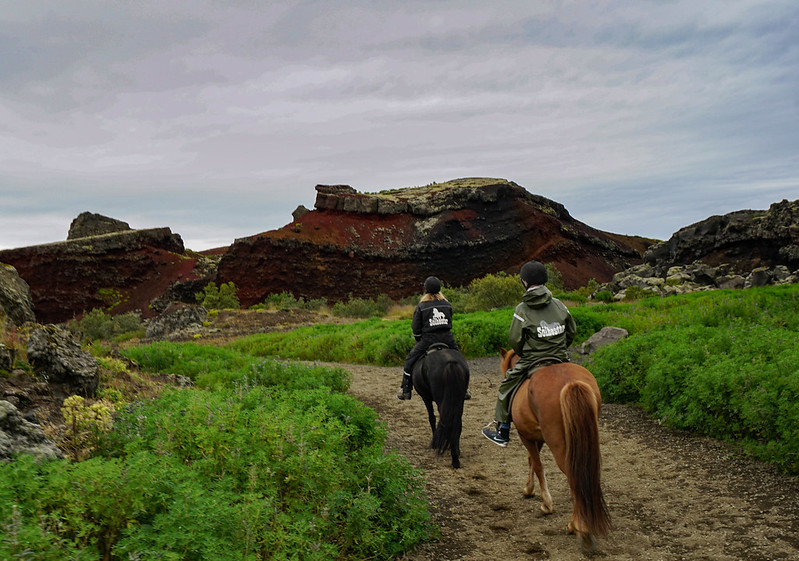
Mathilde is sure we want photos here. Who am I to ever turn down someone's photo idea...
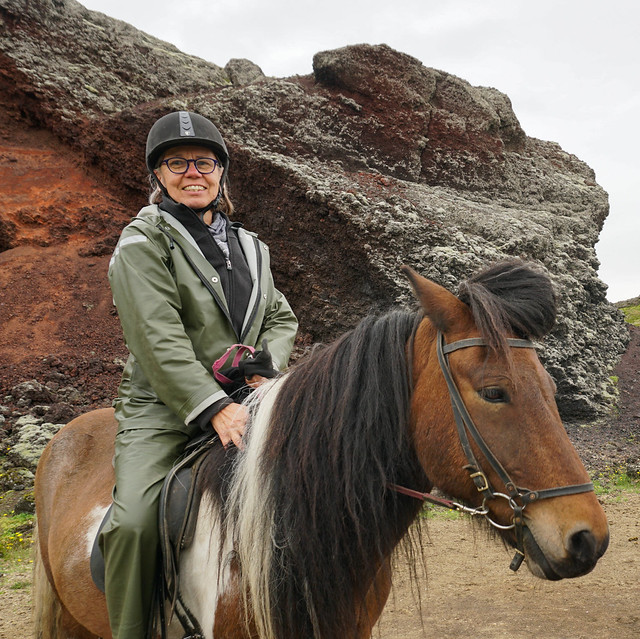
We've done a lot of walking and some trotting and tolting. I ask Mathilde if she ever challenges the riders to an even faster pace.
Do you want to gallop?
I do. I have missed that rocking movement: horse and rider, together, in sync. Jennifer agrees. We're off!
It is fantastic! The horses move easily, rhythmically. We come back to it again and again.
(Mathilde checks back to make sure we're still in our saddles!)
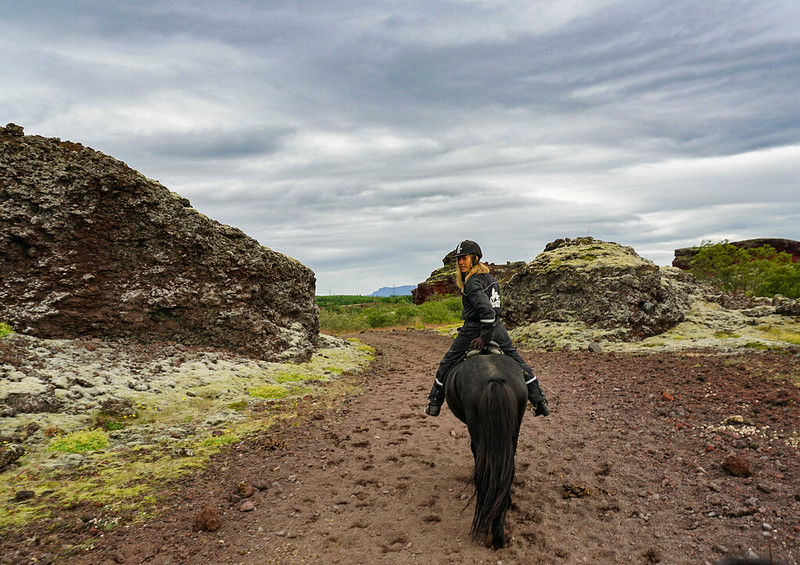
I would not trust us to do a flying pace though! She shouts back from the front.
No, I wouldn't trust myself to be on a horse that could fly with the speed of a hurricane wind.
(We watch other riders taking their third horse out for a spin right by the Red Lake, where in the winter Icelandics race over its frozen waters.)
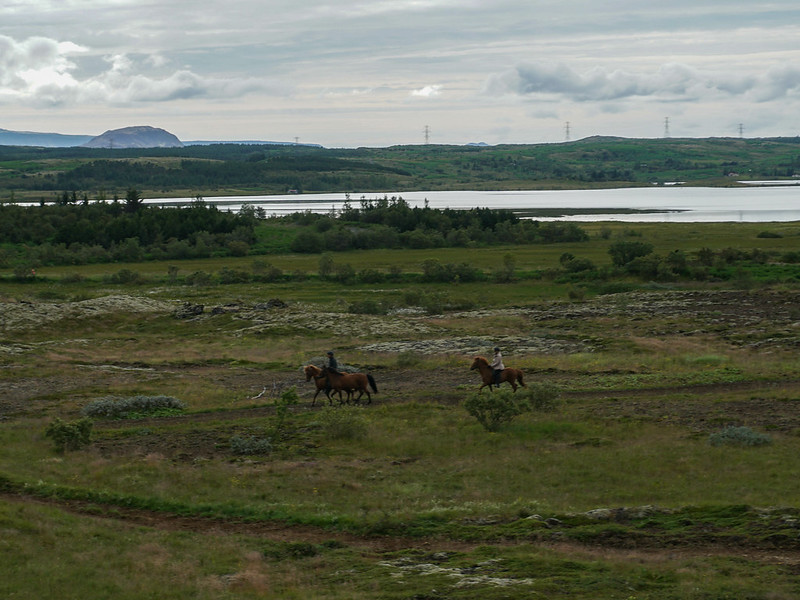
And now we turn the horses home. Despite the cool air, Biknir is sweaty from the ride. Unsaddled, he goes straight for what's good in life. He reminds me of the hens when they are feeling just too warm!)
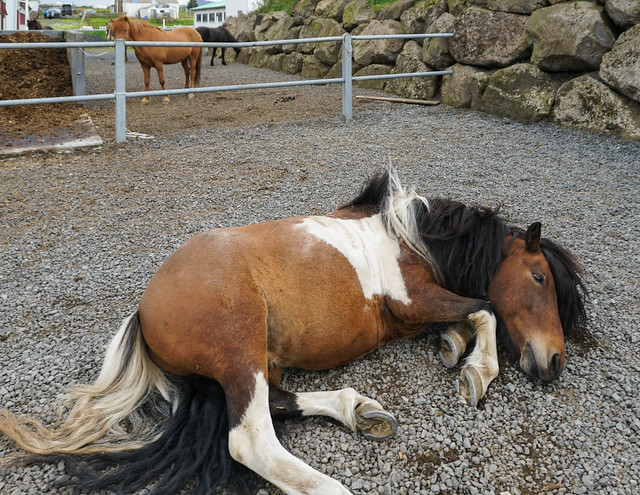
We feed them some horse treats -- they clamor for more, just like the cheepers!
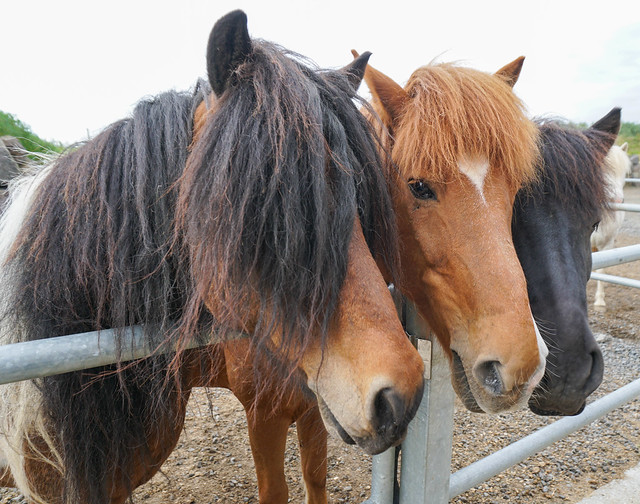
Mathilde asks us to stay for a coffee or tea, but it's getting late. Time to get organized. Time to walk one more time up past the cheerful Reykjavik houses...
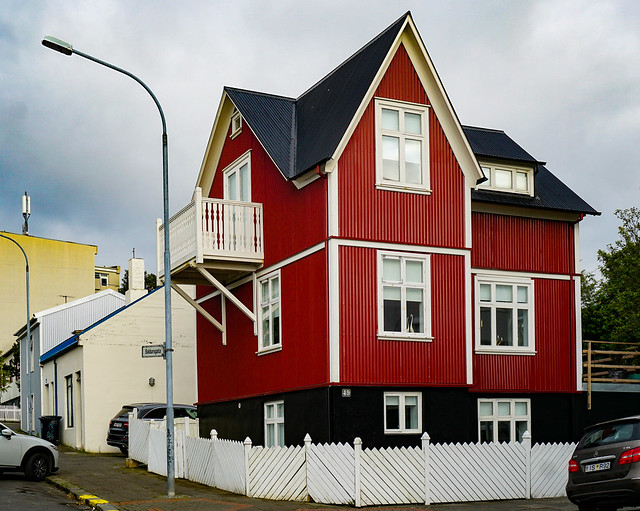
... to a restaurant that I booked for dinner. It's called Kol and it's good, and as everything else -- beastly expensive. I am very glad I could not land a reservation in Reykjavik's top foodie spot (Dill): it would have been more than a stretch.
At Kol, I eat the tiny Icelandic scallops as an entree and then I break from my ever strong reluctance to pick meat over seafood and order lamb. Iceland has a sizeable sheep population and lamb from here is exported far and wide.
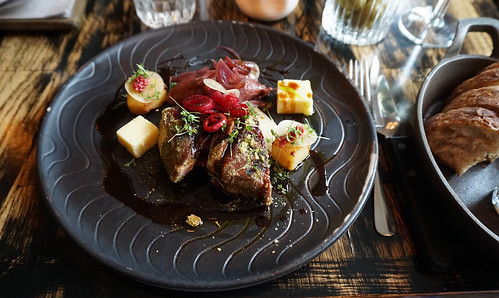
I'm very close to the end of my trip. Tomorrow, I have a predawn bus to catch to the airport. My next post should be from the farmette!

